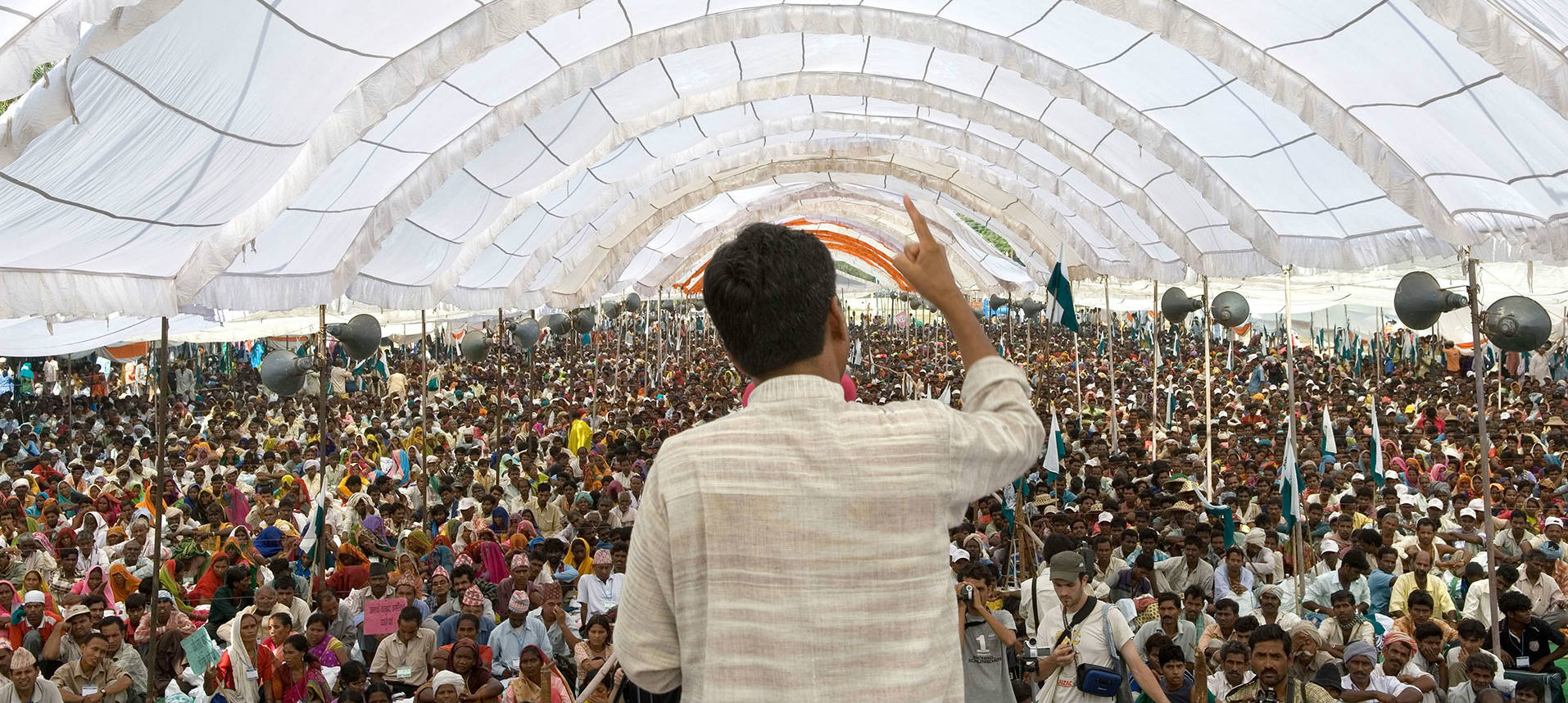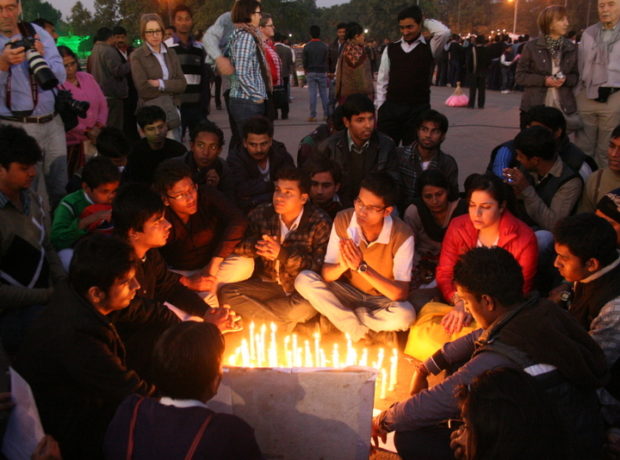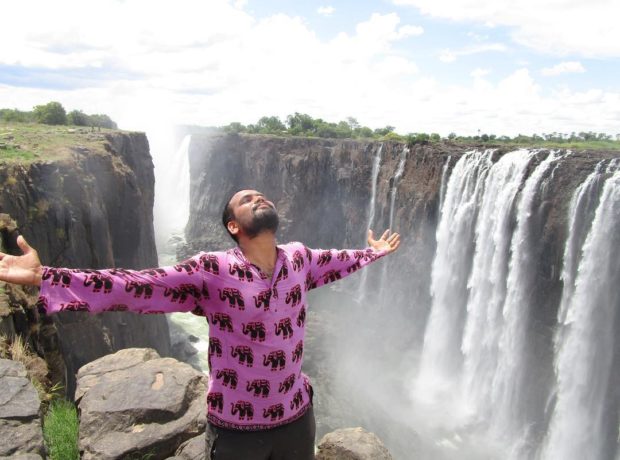Adam Weymouth interviews the inspiring Rajagopal, founder and leader of Ekta Parishad, the landless people’s movement in India that was forged on a commitment to Gandhian principles of non-violence. Breaching the seemingly intractable cycles of conflict and violence against the poorest in India has been at the centre of Rajagopal’s mission for more than 40 years. It has been a lifetime’s endeavour, testifying to the level of commitment his cause has required and he has been willing to bear.
On 2nd October 2012, 50,000 people gathered beneath a vast marquee on the outskirts of Gwailior, in the state of Madhya Pradesh, to hear what Jairam Ramesh, the Rural Development Minister of India, had to say to them. For a year the organisation Ekta Parishad had been crisscrossing the country, twenty campaigners in a caravan of jeeps travelling more than 80,000km, speaking to some of the 400 million Indians who have no land to call their own.
They were the tribal people and the forest dwellers, the nomads and the agricultural labourers, and the dalits, or untouchables, who are outside of the caste system. As the campaigners had travelled, spreading the message of their movement one village at a time, they had also been in negotiation with the government, pushing for reforms that had been promised them five years previously and were yet to be enacted, reforms that centred upon fair and equal access to land for every citizen. Now 50,000 people had made the journey, from every state in the country, to see what the government would offer them.
“There are some issues that we cannot agree on immediately,” the Development Minister said to the massed crowd sat before him. “Unfortunately, to a large extent, our hands are tied.” Although he had agreed two days previously, in a letter, that there was “a very substantial degree of consensus” between the government and Ekta Parishad, it now seemed that he was washing his hands of responsibility. There was little in his speech that anyone saw as meaningful. “As you know, according to our constitution,” he continued, “’land’ is a state subject. The state government is responsible for it.”
“We need our land back in our hands,” shouted one woman.
“We should be able to teach them that the government of this country is the government of its people,” said another. That evening, the assembly took a vote on whether to continue with the original purpose of the gathering, a walk of 350km to New Delhi to put pressure on their government to make good on its word.
Sitting against a white screen in the glare of lights and cameras for our interview, Rajagopal looks as comfortable as he does when out walking for weeks on the national highways of India. He is short, middle-aged and quick to laugh, and he wears a shirt and waistcoat of hand-spun khādī, a hemp cloth promoted by Gandhi as both a means of stimulating rural employment and of sidestepping British control of the cotton industry. That he is halfway through a packed speaker tour does not show, but then Rajagopal is accustomed to long journeys on little sleep. His fight against poverty is focused in India, half a world away, but his lecturing here goes far beyond any abstract notion of fostering solidarity. He is here to build a movement, a movement he believes that we have an obligation to be part of. “Across the globe, wherever I go,” he says, “this is what I am finding. People who are suffering are getting organised and acting. People who are not suffering are not acting the way that they should act. They need to wake up to the reality of what is happening in a globalising world.” It is a belief developed over more than four decades of work, a slow unearthing of the roots of inequality in a country that is home to one third of the world’s poor.
People who are suffering are getting organised and acting. People who are not suffering are not acting the way that they should act.
Rajagopal uses only his first name to avoid being associated with a caste. Born in Kerala, he was a Gandhian from the start. His father fought alongside Gandhi in the struggle for India’s independence, and his school was run under the principles of Nai Talim, a pedagogy that aims to eradicate the distinction between learning and labour, where the emphasis was as much on the spinning of clothes and the growing of food as it was on education in the classroom. Yet the path to his current work was meandering. He trained first as a classical dancer and then as an agricultural engineer. “It was a long journey,” he says, “in terms of trying to find what I really want to do.”
It was Gandhi’s teachings, absorbed during his childhood, that never left him. In 1970 he moved to the Chambal district of Madhya Pradesh, an area rife with gang warfare, with blood feuds and with mercenaries, to see how the practice of nonviolence might play out in a region where the violence was acute. “You can speak about nonviolence,” he says, “you can write about nonviolence, but how can you inspire people unless you really do it yourself?”
The endemic violence he found there, he believed, had its roots in injustice, a continual cycle of wrongs that were never addressed and led only to the propagation of more violence and the formation of a criminal class. “Justice and peace, these are two sides of the same coin. Without justice there is no peace, and in order to achieve peace you need justice.”
With much of Chambal controlled by the gangs the infrastructure was collapsing, the schools and hospitals closed, the fields running fallow. He and his colleagues worked with the younger generation, teaching that anger does not need to manifest in violence but can be used, instead, for positive change. “We were helping them to understand, look, if there’s a problem how do we solve it without taking up a gun? Fire cannot be dealt with by more fire. It is good to be angry about injustice and all that is happening around you. But it is not good that you create more problems with your anger.”
Those young people left their training and initiated a dialogue with the gangs, and by 1974, 670 people had surrendered themselves and their weapons. It was a remarkable turnaround in such a short space of time. “That inspired me in a big way,” he says. “To understand that even in a bandit there is sensitivity. It is a question of you touching it. Do you have the capacity to kindle the good part of the human being so that you can turn them into good people?” It was that inspiration that would drive him for the following forty years.
Poverty, exploitation, and corruption were forms of violence that he came to think of as state-sanctioned, exacerbated by rapacious globalisation and a development model that put corporations before people.
As he continued his work through the 1980s, in various communities across India, he came to realise that he was still failing to tackle the root causes of the problems he was encountering. Hidden by the visceral violence he was experiencing, there was a deeper, indirect violence that was systemic and structural, built into peoples’ lives. Poverty, exploitation, and corruption were forms of violence that he came to think of as state-sanctioned, exacerbated by rapacious globalisation and a development model that put corporations before people. “In a country like India, 70% of people depend on land, forest and water. In a globalising world, these are the resources that are being grabbed by powerful forces. The water-bottling companies take the water, the mining companies take the land, tourism and tiger reserves take the forests. Poor people lose everything. We have a responsibility to take a position with them.” It is easy to nod along as he speaks about the Western companies that are buying up this land, who are complicit in this injustice, to sit with a sense of mute anger and of impotence. But a globalising world, he reminds me, can be as much connected through protest as it is through capitalism. In a globalising world it becomes harder to maintain that these are someone else’s problems.
On paper, India has a land policy that is significantly more radical than we are used to in the West, with no family permitted to hold more than 40 acres. But on paper is more or less where such policies have stayed.
“There is manipulation,” Rajagopal says. “Land is divided in such a way that the father will have 40 acres, the mother will have 40 acres, the daughter will have 40 acres, the son will have 40 acres, the dog will have 40 acres and the cat will have 40 acres.” In practice, a vast number of people in the world’s most populous democracy (Rajagopal estimates 41%) have no right to land at all. 17% are dalits condemned by the caste system to be labourers instead of landowners. 8% are Adivasis, the tribal groups of India, who had no official record of the lands that they traditionally occupied and who have thus been cast aside by dams, by mines and by nature reserves. Nomadic groups have had the commons upon which they once relied for grazing and shelter subsumed by private companies. Fishermen are losing access to their fishing grounds as coastal developments and nuclear plants proliferate along the shore.
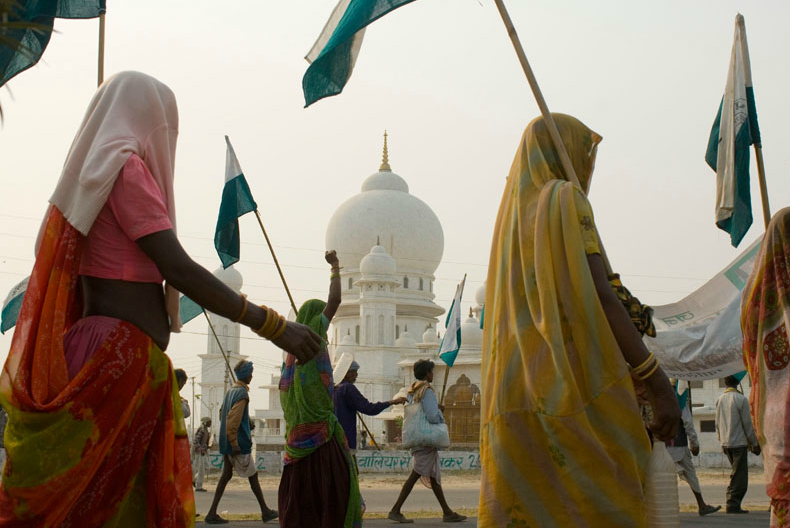
Ekta Parishad. Photo by Simon Williams
In 1991, with the intention of uniting his many projects within one network, Rajagopal formed Ekta Parishad, which translates from the Hindi as Unity Forum. The training of young people and an unwavering commitment to nonviolence have remained at the organisation’s heart. 300 social activists and 12,500 young people, trained by the organisation, led the gathering in Gwailior: this is the core that carries Ekta Parishad’s message back into their many thousands of communities throughout India. It is only through a long term commitment to each individual that Rajagopal believes a movement can be built that is sustainable and far-reaching, and, above all, effective. I am impressed by his conviction that change is a hard fought, long run process, accustomed as I am to social movements that gather hundreds of thousands of members with a couple of clicks of the mouse, the signing of a petition or the proliferation of a hashtag, and who then lose them just as quickly.
“Ekta Parishad was built in the last 25 years, not in one day,” Rajagopal says. “It is important not only to train young people but keep behind them morally, politically, to give them support, so that they sustain their spirit to be honest, committed social workers. In spite of various difficulties, many have stood the test of time. They have proved that they can really go against a system. They can go against temptation, they can go against threat.”
The core of that training rests on principles of nonviolence, which for Rajagopal is not a mere strategy, but a way of life to be thoroughly embraced. As much as it is a form of protest and a means of putting pressure on the government, it is a daily commitment and a way of living. It means not consuming products that cause harm to the land or the community, it means respecting one’s family and one’s partner. “If I am a nonviolent activist and I continue to drink Coca Cola, there’s something problematic about it,” he tells me. “Coca Cola is a company that is going all over the world, extracting the water of ordinary people. They can’t buy Coca Cola and pay one dollar.”
He sees nonviolence as a way of breaking the cycles of violence we are stuck in, be they direct or more structural, and transforming the situation into something new that is beneficial for both sides. “Transformative action means that I want to liberate myself from poverty, but I also want to liberate you from your habit of accumulation. You also have a disease. Accumulation. I want to liberate myself from exploitation. I want to liberate you from the habit of oppressing and exploiting others.” His belief in the potential of nonviolence extends as far as the state, harking back to his work in the 1970s when he came to believe that even the very worst of the criminals could be moved to act in a more compassionate way. Politicians, he feels, have grown to think only of themselves, forgetting that their role is to serve those that they represent. “The state is using so much violence against people,” he says. “Every state should be asked to look at all development through a peace lens, to see whether they are going to create more peace or more conflict. If you are spending so much money on war and military and police, why can’t you spend some money on peace and nonviolence? Why is there no ministry and budget for peace and nonviolence?”
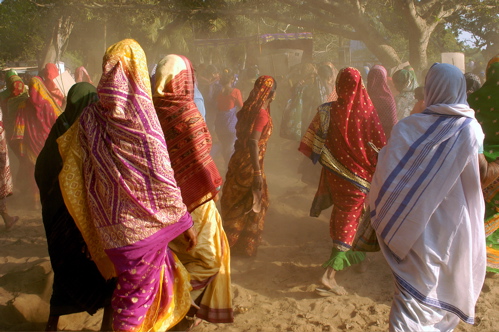
Photo by Simon Williams
Ekta Parishad’s demands focus on land. They want the land taken from the indigenous to be returned to them; the land owned by the poor to be protected from land grabs by the rich; those currently squatting to have that land formally declared as theirs; the vast tracts of land owned by a single individual or corporation to be redistributed amongst those who have nothing. They have also placed a strong emphasis on women having the same rights to land as men, which Rajagopal sees as critical in the development of Ekta Parishad, and challenging the violence that is inherent in a hierarchical society. “It’s like two wheels of a vehicle,” he says. “They have to move together.”
Yet their aims do not end with governmental and legislative reform. Rajagopal is keen to emphasise that the ultimate goal is to enable communities to become self-sustaining and self-governing, in the way that Gandhi envisioned. “Even the parents will not take responsibility to look after their children, so why should the government take responsibility to look after the people? I think we have failed in terms of articulating a development model where communities will take responsibility for their own well-being. We create a state, a very powerful state, and then people are made to run after the state for the delivery of justice. What we are saying is that you decentralise power, give power to the communities, decentralise control over natural resources. We are not asking for anything more.” He draws a comparison with Europe, where now that austerity has truly bitten, those who have become dependent on the welfare system are finding themselves abandoned, with nowhere else to turn. The government, he says, should be working for the people, rather than the other way around, and the current model, where a vote once every five years is all the engagement that citizens are granted, is a far cry from the sort of democracy that Ekta Parishad envisages.
In 2007 Rajagopal convened the first of Ekta Parishad’s yatras. Janadesh (“The Verdict of the People”) was the largest march that had been seen in India since Gandhi’s walks for Independence. A march of such scale would make manifest the extent of the support that the movement had gathered, and it was a form of protest accessible to everyone. “Each one who will be participating in the march is supposed to collect one rupee a day,” he tells me.
“In three years they have a thousand rupees. A thousand rupees is enough for someone to come to Gwailior and march. And everyone is supposed to put away one handful of rice every day before cooking. This one handful of rice every day is a small thing, but in three years this becomes three hundred kilograms of rice. Those who are left behind will have food, and the one who is going on the march will have money. And then they must be ready to walk for a month, because a one day struggle will not make any difference. Nobody cares. You go for a rally for a day and the government will say okay, good, give us the petition and go home. The pressure must sustain.”
To that end, 25,000 villagers walked 350km from Gwailior to New Delhi, demanding that the government identify the land available for redistribution to the landless, and that they create a judicial system that would enable that land to be parcelled out swiftly. When they arrived in New Delhi the government agreed to set up a council on land reform, and promised to take action. Yet by 2011 the council had not met once and Ekta Parishad was planning a second march, twice as big as the first.
“Imagine 50,000 people making a step,” Rajagopal says. “50,000 steps. That’s a political statement, according to me. You are not just walking. ‘I am coming to the capital of this country.’ And it is also a spiritual position. ‘I will suffer in order to motivate you to be different.’ I am not just telling you, sitting around a table, but I am walking in hot sun, I am eating only once in a day, I am sleeping on the national highway, suffering. Suffering as an instrument, as a method, to appeal to the hearts of people in front of you. Walking is political. It is spiritual. It is very participatory.”
“Imagine 50,000 people making a step,” Rajagopal says. “50,000 steps. That’s a political statement, according to me. You are not just walking.
Such walks are part of a long lineage in India, stretching back to the Salt Satyagraha organised by Gandhi to protest the Salt Tax that gave the British a monopoly over the collection and manufacture of salt. Between March and April 1930, Gandhi and his followers walked 240 miles to the coastal village of Dandi, to manufacture their own salt. When he arrived, there were more than 50,000 walking with him. It has been credited with being the first protest of its kind (Solnit, Wanderlust 2000: 58), and since then there have been numerous such walks, both in India and elsewhere, ranging from a few days to many years, from a few miles to the length of continents. From the Jarrow Crusade over mass unemployment, to Satish Kumar’s walk from New Delhi to New York for nuclear disarmament, to coast-to-coast walks in America campaigning for Native American rights, the paths and the motives have been winding and diverse. But there is a common thread through all these journeys, the most simple of human acts that connects us to each other and the land, and a common symbol that blurs the boundaries between the political and the spiritual, between protest and pilgrimage.
Rajagopal tells me how, for many of those marching, much of what they experience is not new. Walking in the hot sun, eating only one meal a day, sleeping in cramped conditions, this is daily life for many. Yet now they are finding something communal in their experience, something different from the poverty to which they are accustomed, that keeps them isolated and powerless. “It is a lot of pleasure,” he says. “Singing and dancing and speaking. That brings people together. They cook together, they walk together, they dance together. And so you build a larger movement. 50,000 walk. Next time, the next 50,000 will be taken care of by this 50,000, because they’ve already learned the technique of walking together.”
Those 50,000 who had gathered in the marquee in Gwailior voted to reject the Rural Development Minister’s words. The next morning they set out on the highway towards New Delhi. The photographs show a sea of green and white striped flags, the colourful saris of the women and the white shirts of the men, bare feet and sandals on the tarmac. They walked for nine days, as far as Agra, and there the government minister came to hold another meeting with them. This time, on a stage in front of the assembled crowds, he signed the peoples’ demands. “Land for every landless family, and home for every homeless family is the promise of the government,” he said. “Not only administratively, but from the point of view of law.”
Ekta Parishad hailed it as a success, and certainly it was, but it seems likely that Jairam Ramesh only capitulated to their demands in Agra to diffuse the arrival of 50,000 people in New Delhi. More than two years on and the government has yet to enact their promises, and now that a new government is in power that signed piece of paper looks ever more insubstantial. The marches have achieved successes: the Forest Rights Act that the 2007 march helped to push through has since returned land to 3.2 million Adivasis; the 2012 march has laid the foundations for the creation of a Homestead Act and a National Land Reforms Policy. Now that these policy documents are drafted Ekta is attempting to have them ratified. They are also somewhat closer to the establishment of fast track courts to manage land redistribution. But there is a gap that the organisation is still failing to bridge. They are very effective at being noticed, but once the marches disperse they are struggling to get the government to implement the reforms they have signed up to. Is it, I ask Rajagopal, a failure of nonviolence? Do the government know, at the end of the day, that they have nothing to really worry about?
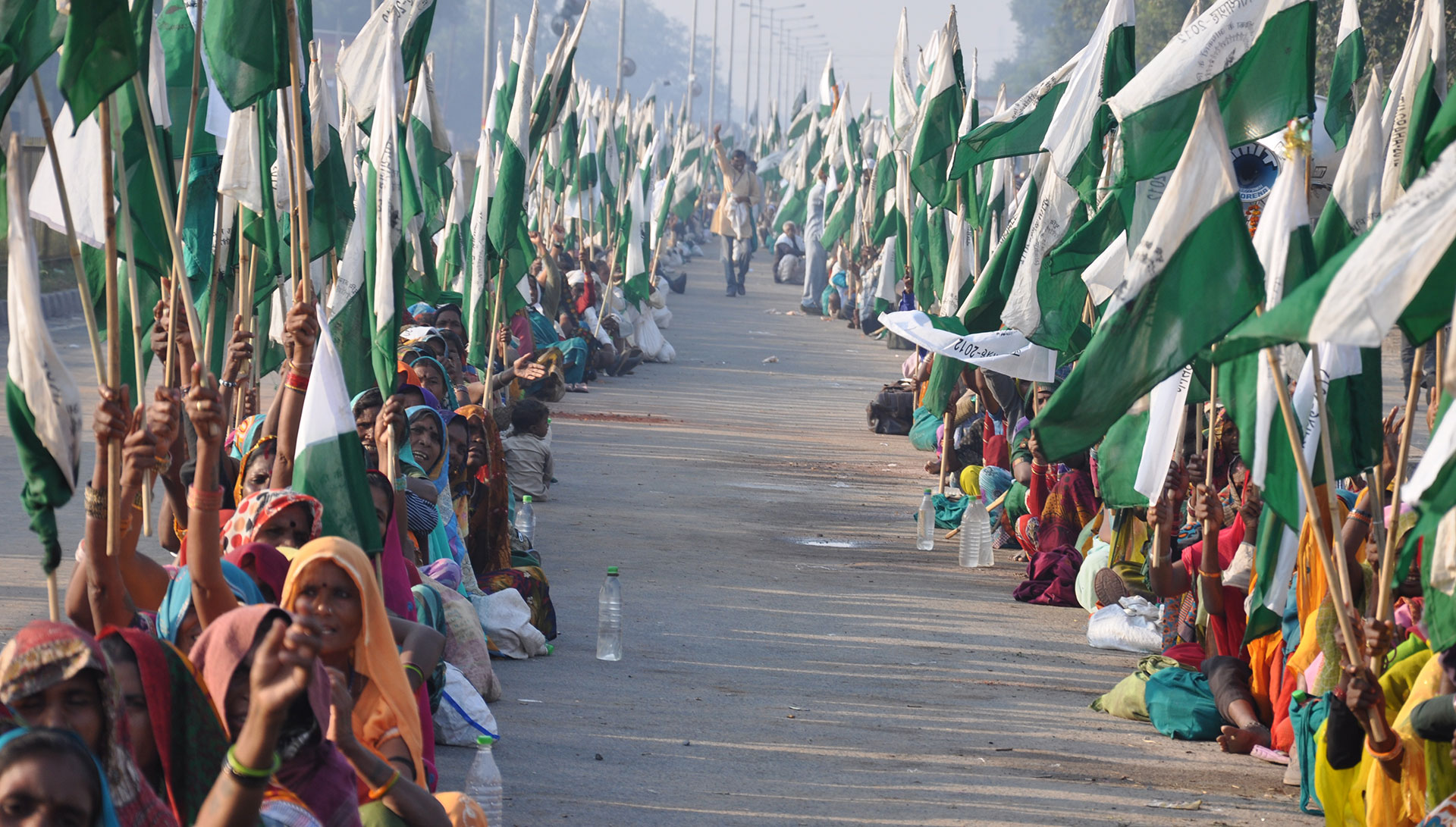
Ekta Parishad
The problem, he says, is that for the time being it is only the landless that are pressuring the government for change. “What is happening today is that people who are economically poor are continuing this struggle, but people who have jumped out of that situation are ignoring it. It is very important poor people get organised, but it should also be supported by people who have gained economic prosperity, and people who have gained educational qualifications. If they wake up to the reality of what is happening in a globalising world, how structural violence is becoming so acute, and start putting their weight behind the organised communities, I think we will bring about a change.” Gandhi spoke not of the well-being of the minority, or even the majority, but of Sarvodaya, the well-being of all. The better off sectors of society have no more right to be complacent than the poorest, he tells me, until this is achieved. This is the message that he wants to bring to Europe.
Over the coming years Ekta Parishad will continue to grow its movement, educating young people, organising conferences, travelling and lecturing. An international woman’s training programme is scheduled for 2016, a forum on nonviolent economy in 2018. It is all building towards a march that will begin in 2019 and last for fifteen months: 8000km from New Delhi to Geneva. A couple of hundred young people will carry Ekta Parishad’s message across half the planet to the front door of the United Nations, a message that has grown over nearly half a century of Rajagopal’s work and is now global in scope, as much as it still pertains to each individual community.
“We want ethics and justice as part of development,” he says. “A development model without ethics and justice is not acceptable. Somebody has to say that.”
He hopes that during those fifteen months a million people will turn out across the world, organising their own marches, carrying that same message to the World Bank, to the IMF, to the WTO, to anybody that needs to hear it. It is overwhelmingly ambitious, but I have no doubt that he can make it happen.
There is little time for rest. As soon as his plane lands in India, he will be walking twenty days to highlight the displacement of Adivasis by wildlife sanctuaries. In the course of the next five years, he hopes that those of us who perform our activism intellectually, from our armchairs, can be moved by such example to take a more meaningful stand alongside those for whom sitting on the sidelines is not a possibility.
“People say they are nonviolent because they’re not taking a gun and shooting anybody. But sitting in the coffee house and speaking about nonviolence is not going to change anything. Preparation should begin now. Thinking about how, in five years time, we will walk together to make a different world. Begin today. Collaborate, cooperate, understand what is happening, exchange information, express solidarity, and slowly build a movement at the global level to make a different world. Build alliances, build a network. Everyone has to act. Sitting down is not going to change anything, so start walking.”
Rajagopal laughs and says: “And if you can run, run!”
